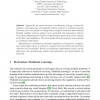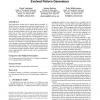1509 search results - page 291 / 302 » Computational Evolutionary Embryogeny |
ATAL
2005
Springer
14 years 2 months ago
2005
Springer
Reinforcement learning problems are commonly tackled with temporal difference methods, which use dynamic programming and statistical sampling to estimate the long-term value of ta...
ECAL
2005
Springer
14 years 2 months ago
2005
Springer
Abstract. Inspired by the recent advances in evolutionary biology, we have developed a self-organising, self-adaptable cellular system for multitask learning. The main aim of our p...
GECCO
2005
Springer
14 years 1 months ago
2005
Springer
GP uses trees to represent chromosomes. The user defines the representation space by defining the set of functions and terminals to label the nodes in the trees, and GP searches t...
GECCO
2005
Springer
14 years 1 months ago
2005
Springer
Self-organization of brain areas in animals begins prenatally, evidently driven by spontaneously generated internal patterns. The neural structures continue to develop postnatally...
GECCO
2004
Springer
14 years 1 months ago
2004
Springer
Portable embedded systems are being driven by consumer demands to be thermally efficient, perform faster, and have longer battery life. To design such a system, various hardware un...


